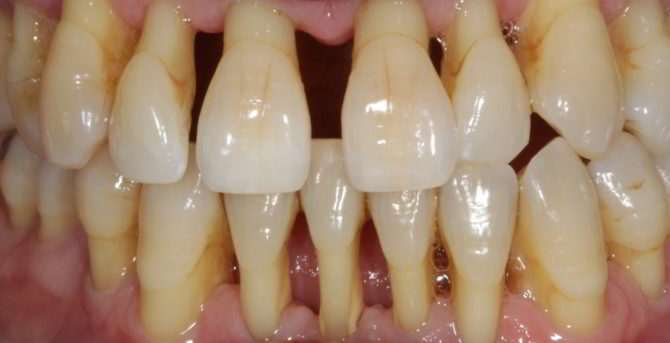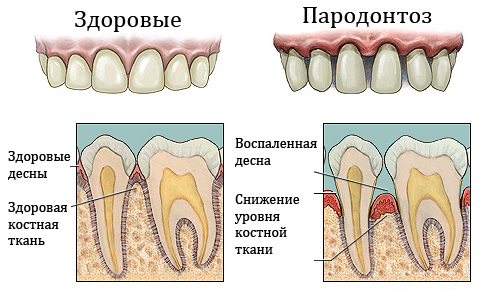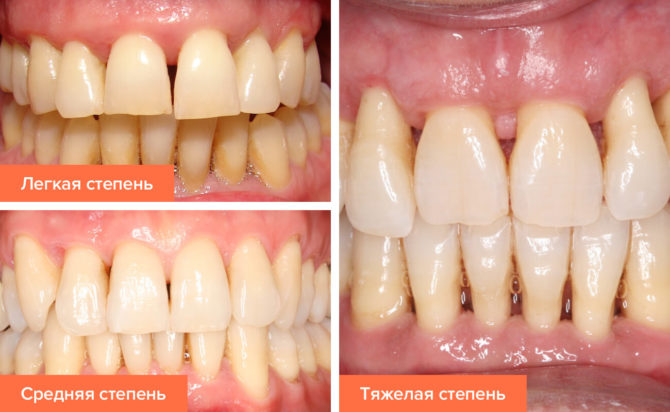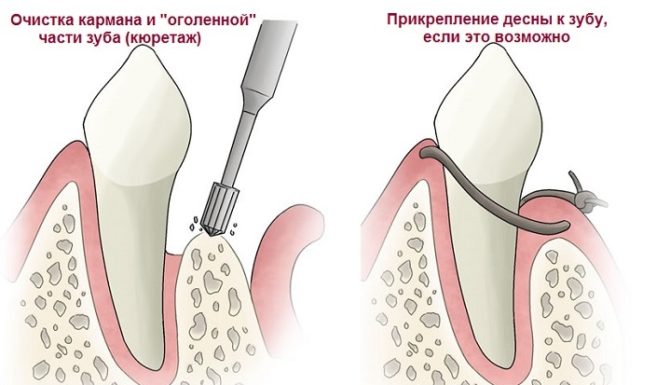How to save teeth during periodontal disease: folk remedies and medicines, herbal treatment
Periodontal disease is a dangerous dental disease that occurs as a result of poor-quality oral care. Prevention of periodontal disease includes full toothbrushing, enrichment of the diet with solid plant foods, timely access to a doctor and prosthetics. The most effective treatment regimen for periodontal disease includes the use of folk remedies in combination with preventive measures and drug therapy.
Content
Causes and symptoms of periodontal disease, complications
Periodontal disease is a chronic non-inflammatory periodontal disease, inflammation in the teeth is called periodontitis. Due to metabolic disturbances in the periodontium, bone tissue begins to collapse, and atrophy of the alveolar processes develops, which is fraught with loosening and loss of teeth. Symptoms of periodontal disease are more often observed in adults, especially the elderly, but the disease can manifest itself even earlier - in young and even childhood.
Depending on the stage and severity, the disease is treated at home or with the help of a dentist. Conservative drug treatment is required only for moderate and severe stages of the disease. At the initial stage of the disease, traditional medicine methods are successfully used.
Before starting treatment of periodontal disease with folk remedies, it is necessary to establish the cause of its occurrence and eliminate it. The main causes of dystrophy of the posterior bone tissue are:
- Lack of fresh vegetables and fruits in the diet (vitamins C and P).
- Inadequate hygiene. When plaque is not completely removed, tartar is formed containing many pathogens that destroy bone tissue.
- Increased load when chewing after extraction of several teeth.
Signs and stages of periodontal disease
The disease develops gradually, the first symptom of periodontal disease is a periodic sensation of pulsation and burning in the gums. At this stage, patients rarely go to the dentist.
A more obvious symptom of the disease is exposure of the root necks of the teeth, which may be accompanied by mild swelling of the gums, putrid odor from the mouth, increased bleeding during brushing and chewing food. If periodontal disease is not treated, the bone will continue to dissolve, and the gums will become thinner. As a result, the tooth roots will be exposed more and more, the teeth will begin to loosen and fall out.
A characteristic sign of periodontal disease is a fan-shaped divergence of the dentition, which is associated with the destruction of the ligamentous apparatus. It is impossible to save teeth on their own at this stage of the disease; dental care is needed.
Possible complications
The disease is non-inflammatory in nature, but it can cause unpleasant complications:
- purulent inflammation of the gums and tissues of the oral cavity - sepsis, pulpitis, abscess, osteomyelitis of the jaw;
- gastrointestinal diseases - ulcers, gastritis, enteritis, colitis;
- multiple damage and tooth loss, which is fraught with a violation of chewing and speech functions.
Folk remedies and methods of treatment of periodontal disease
Periodontal disease can be cured at home, without resorting to the help of a dentist at all, only at the initial stage of the disease. In advanced cases, teeth can be saved only through complex therapy with the use of medications and special procedures. In such cases, alternative methods of treatment are also relevant, but they act as ancillary measures.
The most effective alternative methods of treatment are:
- rinsing the mouth with herbal decoctions;
- rinsing, compresses and gum massage using oils (the most effective are sea buckthorn and fir oils);
- anti-inflammatory compresses on the gums and applications with beekeeping products.
Herbs and plant extracts for periodontal disease
Herbs for periodontal disease were used by ancient healers, but modern dentistry does not deny the value of plants for strengthening gums, disinfecting the oral cavity, stopping inflammation and reducing bleeding. Medicinal herbs can be used separately or in fees.
It is possible to treat periodontal disease with folk remedies based on medicinal plants in different ways: using them for internal use, as rinses, lotions on the gums, compresses, additives in toothpaste during toothbrushing. The most effective recipes:
- When loosening gums, oral bathtubs with oak bark help well. To make a decoction, you need to brew a teaspoon of bark in a glass of boiling water, insist for an hour, after which the liquid needs to be filtered. Do the bath 3 times a day for 2-3 minutes.
- Applications with an ordinary colza help to treat subgingival abscesses. To prepare the infusion, you need to take 2 tbsp. l fresh or dried herbs, pour boiling water (200 ml), steam for two hours, then strain. Applications should be done in the morning, closer to night and between meals. Perform the procedure for two weeks. Every day, it is better to cook a fresh portion of the infusion, you do not need to immediately produce 5 liters of funds so that it lasts for two weeks - during this time its effectiveness will decrease.
- The most effective means for disinfecting the oral cavity and stopping inflammation in the gingival pockets and gums is crushed calamus root. It is recommended to add finely ground powder from the plant to toothpaste, brush your gums and teeth with this mixture every 8 hours for a week. For one cleaning, half a gram of powder will be required.
To cure the inflammatory process, you can rinse your mouth with alcohol infusion of calendula diluted in water (a tablespoon of tincture is poured into a glass of warm water). Alcohol infusions are suitable for adult patients, for children it is better to make a decoction of calendula.
Complex treatment of periodontal disease using alternative methods
Completely cure periodontal disease only folk remedies will not work, they are used as an antiseptic and auxiliary procedures that have a positive effect on the health of the oral cavity and the condition of the gums. To save periodontal tissues, it is necessary to be treated with pharmacological medicines designed to strengthen the gums. When prescribing a course of treatment for periodontal disease, the doctor has several tasks:
- Completely stop or at least dramatically slow down the development of the pathological process in periodontal disease.
- Restore occlusal ratios (closing of teeth).
- In advanced cases, it will be necessary to treat a purulent-inflammatory complication in the gums.
Stages of treatment of periodontal disease
In dental clinics, treatment of periodontal disease is carried out in four stages: elimination of irritants and provoking factors, anti-inflammatory therapy, removal of gingival pockets and fixing the result.
First stage
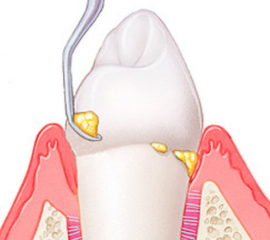 The first stage of therapy is the elimination of local irritants. Most often, plaque and dental deposits act as irritants, but maxillary anomalies that require surgical correction are also possible.
The first stage of therapy is the elimination of local irritants. Most often, plaque and dental deposits act as irritants, but maxillary anomalies that require surgical correction are also possible.
Removal of tartar - a mandatory procedure in the treatment of periodontal disease of the gumsotherwise, it’s pointless to start treating the disease. Plaque is a mechanical obstacle that will not allow gingival pockets to heal and completely cure the disease.
To remove the stone, the doctor can use ultrasonic devices, chemicals or perform manual cleaning. After the stone is removed, the doctor polishes the tooth surface. Gingival pockets are treated with antiseptic solutions.
Second phase
At the second stage, local anti-inflammatory therapy is carried out, it lasts 7-10 days. Additionally, vitamins and enzymes in tablets can be prescribed. Depending on the condition of the oral cavity and the severity of the disease, the doctor prescribes drug or alternative antiseptic solutions for topical use. The use of natural remedies shows high efficiency.
For patients with increased bleeding gums, the doctor prescribes heparin injections or folk remedies:
- Rinsing with St. John's wort infusion. Fifty grams of dry raw material is poured with boiling water (200 ml), infused for three hours. Rinse should be every 2 hours.
- Compresses with nettles. 2-3 tablespoons of dry grass are poured into a glass of boiling water and brewed for half an hour. Then a bandage or gauze is soaked in the infusion and applied to the affected areas for 10-17 minutes. The procedure is performed no more than three times a day.
- Honey and propolis. The products not only eliminate bleeding and inflammation, but also help heal wounds and normalize blood circulation in the gums. Beekeeping products are strong allergens, so use them with extreme caution. Honey and propolis are used to make rinses and compresses.
In the treatment of dental diseases, a ten percent tincture of propolis is often used. It is used in diluted form: 15–20 drops of tincture in 200 ml of water. Rinse your mouth with this product after eating. To make a compress you need a natural product. A piece of propolis is kneaded into a thin strip and applied to the gums for 1.5–2 hours, you need to do this once a day.
Third stage
After the inflammatory processes are eliminated, it is necessary to eliminate the pathological gingival pockets. Pockets up to two millimeters deep are removed conservatively by the introduction of proteolytic drugs, enzymes and antibiotics. 10-12 procedures are performed. Curettage and gingivectomy will help to remove deep pockets.
Fourth stage
The final stage of therapy is based on fixing the result and blocking the dystrophic process in periodontal tissues. Means are used to improve blood microcirculation in the gums.
Treatment of periodontal disease with folk remedies involves not only the use of herbal decoctions and herbal compresses, but also the performance of special exercises to strengthen the ligamentous and maxillary apparatus. Due to the tension in the jaw muscles an additional blood flow to the periodontium occurs, gymnastics helps to strengthen even loose teeth. It is useful not only for adults, but also for children as a prophylaxis.
The following exercises are recommended:
- The first exercise is the simplest, but its first time should be performed very carefully - you need to slightly nibble a twig of any medicinal plant with translational movements. Perform for three weeks.
- The second exercise is allowed to begin two weeks after mastering the first. It is aimed at strengthening the jaw apparatus. Technique: grip the twig tightly with your teeth and move your jaws left and right, back and forth. Perform for a month.
- After another month, you can proceed to the last exercise. Hold one end of the branch tightly with your hand, and the other with your teeth and pull the branch onto yourself, as if trying to tear a piece from it. Perform another month.
Heal from periodontal disease without proper treatment will not work.As soon as the first signs of the disease appear, you should immediately consult a periodontist. Only a doctor can correctly diagnose, establish the cause of the pathology and prescribe the optimal treatment. With periodontal disease of the teeth, one can not rely only on folk remedies and, moreover, use them uncontrollably.

